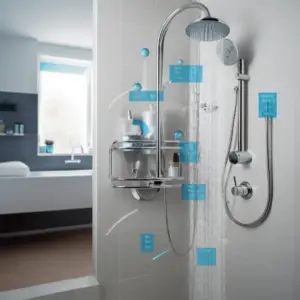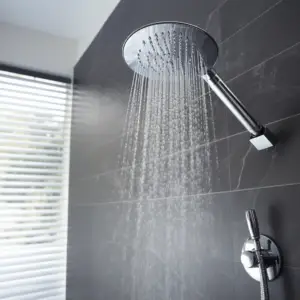Shower Repairs, So you’ve just finished your shower and turned it off, but water keeps on spilling out no matter how much you maneuver the faucet; don’t panic. Instead, turn off the water at the main shut-off to block the water supply throughout your entire house so the showerhead stop running. Now that the water is partially under control, go ahead and figure out how to fix the shower.
Shower Won’t Stop Running: This is How to Manage it

The most suitable way to manage such an issue is often based on what would be causing it; which could be a list of problems. To fix a shower that won’t stop running, you can try tightening the faucet or consider replacing the faulty valve or cartridge. More complete instructions for this process are discussed below:
Material required
Before you start working on the faulty shower, check that you have the following items:
- Replacement cartridge
- Vice grip
- Screwdriver
Tightening the Faucet
Although there’re various reasons why a shower may continue running, opting for the easiest idea can be a great head start.
Grab a flathead screwdriver and pry the underside the cover plate of the faucet. This should help you see the faucet screw and check whether you just need to tighten it.
Then reinstall the cover plate on the faucet, and turn the water back on and check if turning the faucet handle does what it is meant for.
If there’re no leaks, it worked. In case the shower won’t shut off yet, repeat the process of tightening the faucet and try to do it with enthusiasm this time.
Replacing the Cartridge
If tightening the handle screw doesn’t yield any results, the problem is likely to be with the cartridge. To resolve this, turn off the water supply first. Check that you’ve completely shut off the water supply in your home, open a faucet in any of your sinks.
The next thing is to close the drain of your shower. This will help to keep you from dropping any of your screws or such small parts down the drain during the process.
Next up, you have to remove the handles. Look for the small screw and remove it with the aid of a screwdriver. After that, remove the screw that keeps the cartridge and the turning plastic device in place.
As these parts become loose, try to slide them off gently. Check for the clip that holds the cartridge and remove it as well. Don’t throw this clip away because you’ll use it again after installing the brand-new cartridge.
One best way to keep your small parts from missing is to place them all in a safe spot. Once you have removed the clip, you can remove the cartridge as well. You might want to use a pair of vice grips to do this.
While removing the cartridge, be extra careful of the pipes inside so you don’t end up damaging them. In case you’re having difficulties trying to remove the cartridge, just stop and call a professional for assistance.
Installing a New Cartridge
Now that you have successfully removed the faulty cartridge, you can go ahead and install the new one. The brand new cartridge should come with a special lube, meant to ease the installation.
Before you insert the new cartridge, check that the hot and cold sections line up the same way as you removed the old model. Carefully slide the cartridge in and then reassemble all the other parts.
Remember to tighten all the screws before turning the water back to test the shower faucet. Then turn off the faucet on and off to see if everything’s back to normal. In case replacing the cartridge still doesn’t work, then it might be high time to schedule a service.
Shower Maintenance Tips
Shower Repairs almost certain that you’ll experience problems with your shower. Not to mention that your showerhead can be a habitable ground for different kinds of bacteria to thrive. It is therefore important to keep your shower in good condition; clean, safe, and functioning. When you want to clean your shower as well as the faucet, consider going easy on the grout.
Rather than using abrasive cleaners, opt for gentle alternatives like water and baby shampoo. Put a soft nylon brush on the solution, and then start wiping away. In case you notice that the water is weak, check if there’s low water pressure in your house. Where the faucet is working fine, inspect the showerhead for any buildup.
Also, you might want to invest in calcium and lime solution to eradicate any buildup that may be causing be causing blockage on the spray jets. If you’re planning to update your showerhead, consider the one with rubber-tips jets. These are easy to clean with a simple wipe using a cloth.
Call a Plumber

Resolving a faulty shower is only doable if you have the appropriate tools and a little bit of patience. However, when the problem is beyond the faucet, you have to consider calling a professional to take over. But how do you determine if the problem in hand truly requires a plumber? If your DIY methods no longer yield results, then it’s high time for a pro to step in.
Shower Repairs realize the water is slowly going down the drain and your plunger won’t work, then a plumber can help take care of the clog. In case there’s little to no water pressure on your shower, then the problem could stem from the clog on the faucet’s aerator. That said, if your hot shower doesn’t provide you any heat, then the heating system could be malfunction. For such cases, it’s always best to call a plumber.
The Bottom Line
Understanding what to do when your shower won’t stop is a must for every homeowner. Shower Repairs is an important part to make sure you and your family get the best from your home. It will save you from wasting water and get your shower back to normal. While replacing a faucet can be rather expensive, you might want to call for professional services if the problem is too much to handle.
